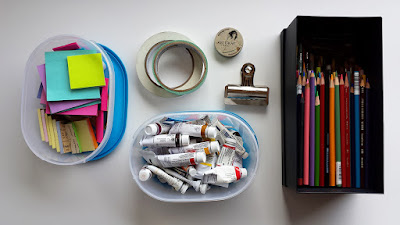For drawing & inking:
-My favorite pencils are Faber Castell 9000 in HB. I'm sure there are nicer pencils out there (some of my grad school friends swore by these Tombow pencils, and I know lots of illustrators who love the Blackwing), but for some reason that I can't quite put my finger on, I'm partial to Faber Castell.
-I've had my Alvin Glass Inkwell sharpener for about ten years and it's still going strong.
-I usually buy whichever kneaded eraser happens to be on sale, but I'm sort of partial to this one.
-My trusty green tape measure has been in my life for a long time and I sort of feel weirdly attached to it. I use it to measure out the size of each illustration onto my paper and while I've used other tape measures none of them has been quite as comforting as Little Green. Also, I'm pretty sure Little Green is instilled with luckiness, which is maybe why I'm so fond of her. (Do you have superstitious attachment to any of your supplies?)
-My ink of choice is FW acrylic ink. It comes in lots of different colors (I mostly use sepia and occasionally white) and I like its fluidity. I pour the ink into a wide mouth, tight sealing container, so it's easier to dip my pen into. Also, if I want to thicken the ink slightly I leave the lid of the ink container open for awhile (overnight), and alternatively, to thin the ink I just add a little water. Once acrylic ink is completely dry it's water fast which means that my watercolor paint doesn't affect my ink lines.
-I've experimented with lots of different pens and the one that works best for me is the Speedball Standard Pen Holder with a #512 nib. I think pens and different pen nibs are highly personal and if you're interested in using a dip pen I encourage you to experiment with as many nibs as possible until you find one that suits you.
For painting:
-My favorite brushes are short-handled round brushes. Investing in a good quality large brush for big, loose washes was sort of life changing. Adding a good wash brush to my arsenal made covering large areas of paper (for sky, water, etc) suddenly fun and free instead of terrifying. For the rest of my painting I use Winsor & Newton Cotman round brushes in sizes 3, 5, and 10.
-For watercolor paints I prefer Holbein and Winsor & Newton Professional grade. My color palette varies a bit from image to image, but the colors pictured above are the ones I use most often.
-I've had my paint palette for a long time and by now it feels like an old friend. Here's one that's similar.
-It isn't included in the photo, but I also rely heavily on Scmincke masking fluid. Its squeeze tube makes applying it fairly easy, and as long as you remove it gently and within 24 hours of application it comes off easily and without damaging the paper. (I use the colorless version.)
-I always have two jars of water while I'm painting and I change the water often (pretty much anytime I switch to a new color) to keep my colors from becoming muddy. I also keep a roll of paper towels at hand and use a paper towel to soak excess paint off my brush or from the paper.
Paper and preparation:
-My paper of choice is Arches 140 lb. hot press in bright white. Although, lately I've been experimenting with other brands and with cold press papers. (Hot press paper has a smoother finish and cold press papers are more textured.)
-In order to achieve a stable surface that won't buckle under very wet watercolor washes I stretch my watercolor paper by soaking it in water and then stapling it onto 1/2 inch Gatorfoam Board. I used to use plywood, but I prefer gator board because it's light weight but sturdy. (Usually a single row of staples is sufficient, but because I live in the very dry Colorado mountains I use a double row of staples on large paintings otherwise the paper dries so tightly that the staples pull out.)
-A note about stretching paper: I stretch my paper AFTER I've drawn and inked my image. As mentioned above, once the acrylic ink is dry it doesn't budge so there's no danger in soaking my inked drawings. Stretching seems to slightly change the texture of the paper which makes the ink lines a bit more difficult to apply, which is why I stretch the paper after the drawing is complete.
Additional Miscellaneous supplies:
-I'm a huge fan of post-it notes and use them for to-do lists, to keep track of deadlines, and to put notes about illustrations on my drawing table.
-I use masking tape and bull dog clips to attach reference material to my drawing table.
-Plastic containers make for handy storage of paints and other supplies.
-I use the occasional colored pencil and love experimenting with water-soluble graphite.
I hope you found some inspiration here! I'd love to hear about your favorite supplies!
------------------------------------------------------------------------------------------------------------------
Brooke Boynton Hughes lives in Colorado's Rocky Mountains where she illustrates children's books. To see more of her work please visit www.BrookeBoyntonHughes.com













Post a Comment